Identification and Compensation for D-Dot Measurement System in Transient Electromagnetic Pulse Measurement
Abstract
1. Introduction
2. System Identification of the Hammerstein Model in Continuous Time
3. Two-Step Identification Method for Broadband Measurement System
- Under the measuring system’s test criteria and the actual working environment, an acceptable time-domain dynamic calibration experiment is created. One must set a low sampling rate to perform low-frequency and long-time sampling on the measurement system to obtain the input and output time-domain signals xL(t) and yL(t); then set a high sampling rate to perform high-frequency and short-time sampling on the measurement system to obtain the input and output time-domain signals xH(t) and yH(t).
- For a broadband EM pulse measurement system with band-pass characteristics, several octaves often differ in the upper and lower cut-off frequencies. Therefore, it is equivalent to a band-pass filter that consists of a low-pass filter GL(s) and a high-pass filter GH(s), that is, G(s) = GL(s)GH(s). During the low-frequency calibration process, we select the input excitation signal xL(t) with a long duration and rich low-frequency components, so that the low-pass component GL(s) obtained by the system identification has an all-pass characteristic similar to this low-frequency excitation signal. At the same time, since GL(s) and GH(s) are multiplicative, it can be assumed that the steady-state gain of GL(s) is 1, and then we can obtain the following equation:YL(s) = GL(s)GH(s)XL(s) = GH(s)XL(s)Therefore, according to the input signal xL(t) and the output response signal yL(t) of the measurement system, the high-pass component GH(s) of the system can be identified.
- By filtering the high-frequency signal xH(t) through GH(s) to remove any low-frequency components, the output signal x′H(t) can be obtained, which is employed as the input of the low-pass component in its identification. The equation presented is as follows:In this way, the low-pass component GL(s) of the system can be identified by using x′H(t) and yH(t).
- Based on GL(s) and GH(s), the identified model of the broadband measurement system is calculated with G(s) = GL(s)GH(s), and then the model is simplified by canceling the similar zero poles.
- The identification model is validated with the test data. If the accuracy of the identification model meets the specifications, identification modeling is complete. Or, if there is a considerable difference between the output of the identified model and the actual output of the system, one can review the experimental design, model structure selection, etc., and then return to the appropriate steps to reidentify the system model.
4. D-Dot Sensor Identification and Compensation
4.1. Experimental Design
4.2. System Identification for D-Dot Measurement System
4.3. Compensation for D-Dot Measurement System and Output Signal Recovery
5. Conclusions
- (1)
- A continuous-time identification approach for nonlinear system modeling of electromagnetic pulse measuring systems under quasi-step pulse excitation is suggested based on the Hammerstein model. This method compensates for the inaccuracy of the linear model in the characterization of the actual test system and expands the application of the Hammerstein model in modeling electromagnetic pulse measuring systems.
- (2)
- A two-step strategy for dynamic identification is proposed in light of the difficulty of constructing the mathematical model of the broadband EM pulse measurement system. The method successfully integrates the low-frequency and high-frequency dynamic calibration data collected from a laboratory experiment. The model identified by this method can reveal the dynamic characteristics of the measurement system in the low- to high-frequency range.
- (3)
- With the given identification algorithm, the Hammerstein model of the D-dot sensor for EM pulse measurement is obtained as a combination of a fourth-order polynomial nonlinear element and a fourth-order transfer function linear element. By designing the corresponding compensation system, the lower limit cut-off frequency of the measurement system is improved from kHz to near DC, and the steady-state response time is decreased from μs to ns. The sensor’s nonlinear characteristics are also effectively corrected.
Author Contributions
Funding
Institutional Review Board Statement
Informed Consent Statement
Data Availability Statement
Acknowledgments
Conflicts of Interest
References
- Wilson, P.F.; Ma, M.T. Fields Radiated by Electrostatic Discharges. IEEE Trans. Electromagn. Compat. 1991, 33, 10–18. [Google Scholar] [CrossRef]
- Azirani, M.A.; Ariannik, M.; Werle, P.; Akbari, A. Optimal Frequency Selection for Detection of Partial Discharges in Power Transformers Using the UHF Measurement Technique. Measurement 2021, 172, 108895. [Google Scholar] [CrossRef]
- Jin, M.; Hu, M.; Li, H.; Yang, Y.; Liu, W.; Fang, Q.; Liu, S. Experimental Study on the Transient Disturbance Characteristics and Influence Factors of Pantograph–Catenary Discharge. Energies 2022, 15, 5959. [Google Scholar] [CrossRef]
- Huang, C.; Yin, H.; Xu, P.; Zhang, B.; He, J.; Liu, J. Prediction of Radio Interference from HVDC Transmission Lines Based on Corona Discharge Characteristics. High Volt. 2020, 5, 679–687. [Google Scholar] [CrossRef]
- Cai, L.; Hu, Q.; Wang, J.; Zhou, M.; Li, Q.; Su, R.; Huang, Y. Differences between Triggered Lightning Striking to Ground and Distribution Line Inferred from Measured Currents and Electromagnetic Fields. High Volt. 2022, 7, 705–717. [Google Scholar] [CrossRef]
- Kong, X.; Xie, Y.; Xing, W.; Sun, Z.; He, S.; Liu, L.; Qiu, P.; Ni, X.; Zhang, K. Noninvasive and Accurate Measuring Method of the MMC and HVDC Circuit Breaker Action Moment Based on Transient E-Field Pulse. IEEE Trans. Power Electron. 2022, 37, 13332–13342. [Google Scholar] [CrossRef]
- Baum, C.; Breen, E.; Giles, J.; O’Neill, J.; Sower, G. Sensors for Electromagnetic Pulse Measurements Both inside and Away from Nuclear Source Regions. IEEE Trans. Antennas Propagat. 1978, 26, 22–35. [Google Scholar] [CrossRef]
- Zhao, M.; Zhou, X.; Chen, Y. A Highly Sensitive and Miniature Optical Fiber Sensor for Electromagnetic Pulse Fields. Sensors 2021, 21, 8137. [Google Scholar] [CrossRef]
- Kichouliya, R.; Satav, S.M.; Pande, D.C. Experimental Investigation of D Dot Sensor Performance in Frequency Domain. IEEE Electromagn. Compat. Mag. 2019, 8, 53–57. [Google Scholar] [CrossRef]
- Taka, Y.; Kawamata, K.; Ishigami, S.; Minegishi, S.; Fujiwara, O. Verification of Measurement Waveforms of Transient Electric Field Caused by Micro-Gap Spark Using Optical Electric Field Probe. IEEJ Trans. FM 2018, 138, 482–489. [Google Scholar] [CrossRef]
- Kong, X.; Xing, W.; Xie, Y.; Zheng, Z.; Sun, Z. A Broadband Optical Fiber Transmission-Based Time Domain Measurement System for Nanosecond-Level Transient Electric Field. Rev. Sci. Instrum. 2022, 93, 014701. [Google Scholar] [CrossRef] [PubMed]
- Lopez-Roldan, J.; Pater, R.; Poirier, S.; Birtwhistle, D.; Tang, T.; Doche, R.; Blundell, M. Development of Non-Intrusive Monitoring for Reactive Switching of High Voltage Circuit Breaker. Int. J. Electr. Power Energy Syst. 2014, 61, 219–228. [Google Scholar] [CrossRef]
- Jiang, Y.; Meng, C.; Xu, Z.; Wu, P.; Zhang, M.; Zhong, M. A Deconvolution Method for Signal Recovery of Electromagnetic Field Sensors. Measurement 2021, 178, 109380. [Google Scholar] [CrossRef]
- Yan, Y.; Jiang, T.; Chen, J.; Liu, X.; Meng, L.; Cheng, Z.; Liu, Z. Study of the Time-Domain Electromagnetic Pulse Standard Field Generation Setup and Its Application. Rev. Sci. Instrum. 2018, 89, 074703. [Google Scholar] [CrossRef] [PubMed]
- Yunsheng, J.; Cui, M. Research on Calibration Accuracy of D-Dot Transient Electric Field Sensor. In Proceedings of the 2017 IEEE Conference on Antenna Measurements & Applications (CAMA), Tsukuba, Japan, 4–6 December 2017; pp. 69–71. [Google Scholar]
- Przesmycki, R.; Bugaj, M.; Wnuk, M. Validation of the D-Dot Probe for HPEM Pulsed Electromagnetic Field Measurements. In Proceedings of the 2018 2nd URSI Atlantic Radio Science Meeting (AT-RASC), Gran Canaria, Spain, 28–31 May 2018; pp. 1–4. [Google Scholar]
- Wang, K.; Duan, Y.; Shi, L.; Qiu, S. Laboratory Calibration of D-Dot Sensor Based on System Identification Method. Sensors 2019, 19, 3255. [Google Scholar] [CrossRef] [PubMed]
- Ouyang, H.; Yao, X.; Chen, J. Development of a Transient Magnetic Field Sensor Based on Digital Integration and Frequency Equalization. Sensors 2021, 21, 4268. [Google Scholar] [CrossRef]
- Kong, X.; Xie, Y.-Z.; Li, Q.; He, S.-Y.; Jin, Y.-B. Development of One-Dimensional Norm Detector for Nanosecond-Level Transient Electric Field Measurement. IEEE Trans. Electromagn. Compat. 2017, 59, 1035–1040. [Google Scholar] [CrossRef]
- Liu, W.; Liu, S. Dynamic Performance Analysis and Experimental Research of Active Transient Electric Field Test System. J. Microw. 2019, 35, 12–17. [Google Scholar] [CrossRef]
- Jakubowski, J.; Kuchta, M.; Kubacki, R. D-Dot Sensor Response Improvement in the Evaluation of High-Power Microwave Pulses. Electronics 2021, 10, 123. [Google Scholar] [CrossRef]
- Si, D.; Wang, J.; Wei, G.; Yan, X. Method and Experimental Study of Voltage Measurement Based on Electric Field Integral With Gauss–Legendre Algorithm. IEEE Trans. Instrum. Meas. 2020, 69, 2771–2778. [Google Scholar] [CrossRef]
- Gupta, M.; Relan, B.; Yadav, R.; Aggarwal, V. Wideband Digital Integrators and Differentiators Designed Using Particle Swarm Optimisation. IET Signal Process. 2014, 8, 668–679. [Google Scholar] [CrossRef]
- Huang, F.; Yan, Y.; Chen, J.; Liu, Z.; Wang, B. Calibration Uncertainty Evaluation of D-Dot Sensors. Prog. Electromagn. Res. Lett. 2019, 83, 115–122. [Google Scholar] [CrossRef]
- Rubinstein, M.; Bermdez, J.; Rakov, V.; Rachidi, F.; Hussein, A. Compensation of the Instrumental Decay in Measured Lightning Electric Field Waveforms. IEEE Trans. Electromagn. Compat. 2012, 54, 685–688. [Google Scholar] [CrossRef]
- Jiang, Z.-D.; Zhou, B.-H.; Qiu, S.; Shi, L.-H. Time-Domain Calibration of the LEMP Sensor and Compensation for Measured Lightning Electric Field Waveforms. IEEE Trans. Electromagn. Compat. 2014, 56, 1172–1177. [Google Scholar] [CrossRef]
- Mete, S.; Ozer, S.; Zorlu, H. System Identification Using Hammerstein Model Optimized with Differential Evolution Algorithm. AEU Int. J. Electron. Commun. 2016, 70, 1667–1675. [Google Scholar] [CrossRef]
- Unbehauen, H.; Rao, G.P. A Review of Identification in Continuous-Time Systems. Annu. Rev. Control 1998, 22, 145–171. [Google Scholar] [CrossRef]
- Garnier, H.; Young, P. Time-Domain Approaches to Continuous-Time Model Identification of Dynamical Systems from Sampled Data. In Proceedings of the 2004 American Control Conference, Boston, MA, USA, 30 June–2 July 2004; Volume 1, pp. 667–672. [Google Scholar]
- Knapp, C.; Carter, G. The Generalized Correlation Method for Estimation of Time Delay. IEEE Trans. Acoust. Speech Signal Process. 1976, 24, 320–327. [Google Scholar] [CrossRef]
- Abe, S.; Zaitsu, T.; Obata, S.; Shoyama, M.; Ninomiy, T. Pole-Zero-Cancellation Technique for DC-DC Converter. In Advances in PID Control; Yurkevich, V.D., Ed.; InTech: Vienna, Austria, 2011; Volume 10, pp. 189–208. ISBN 978-953-307-267-8. [Google Scholar]



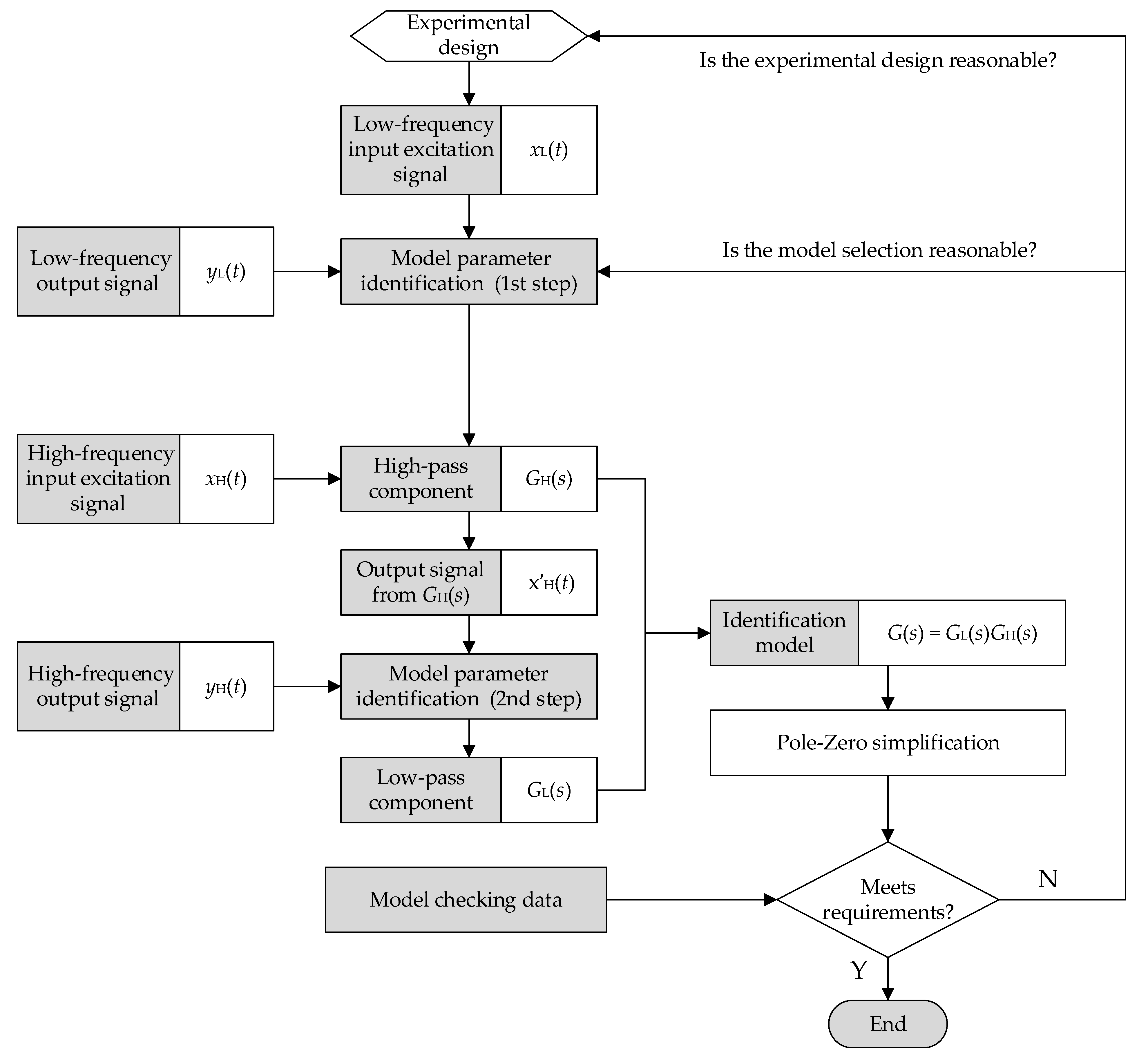

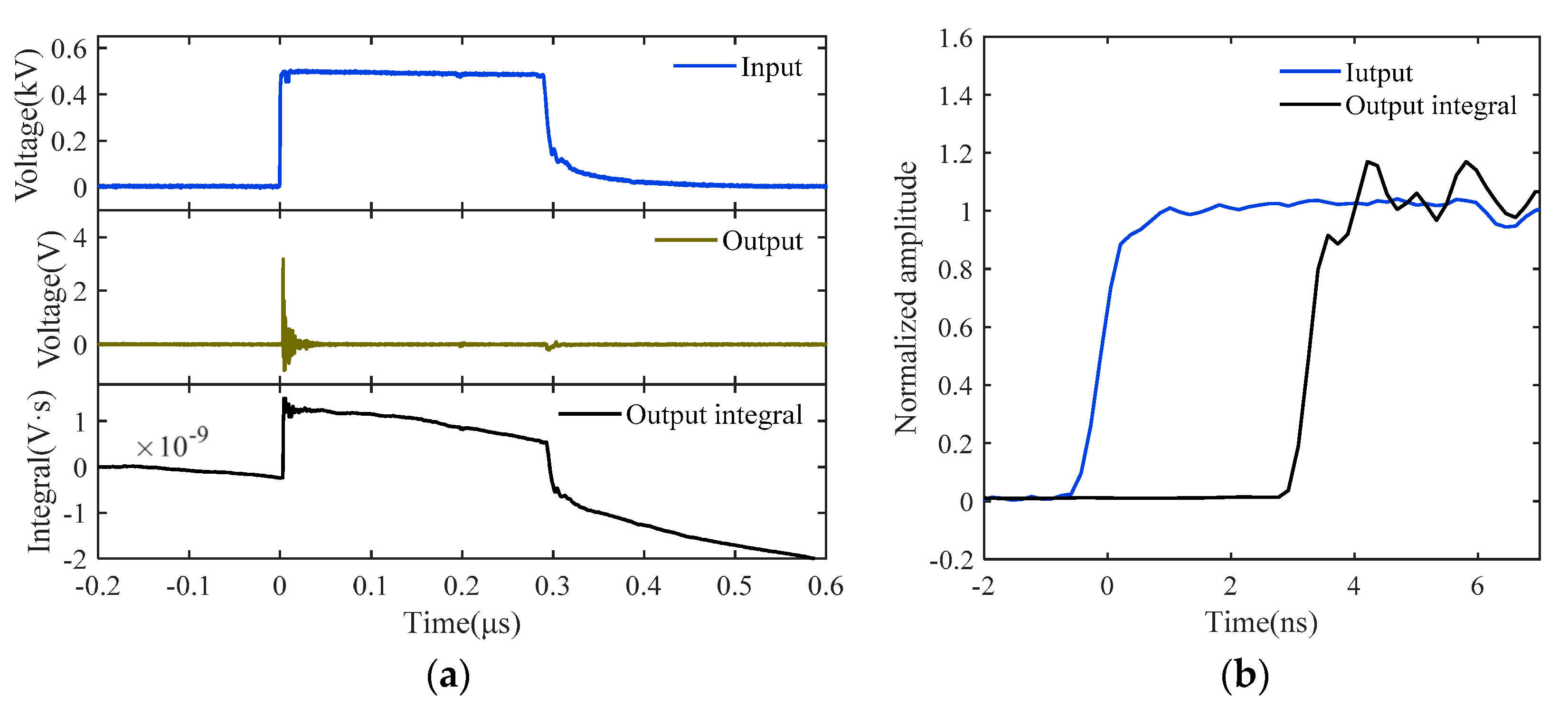


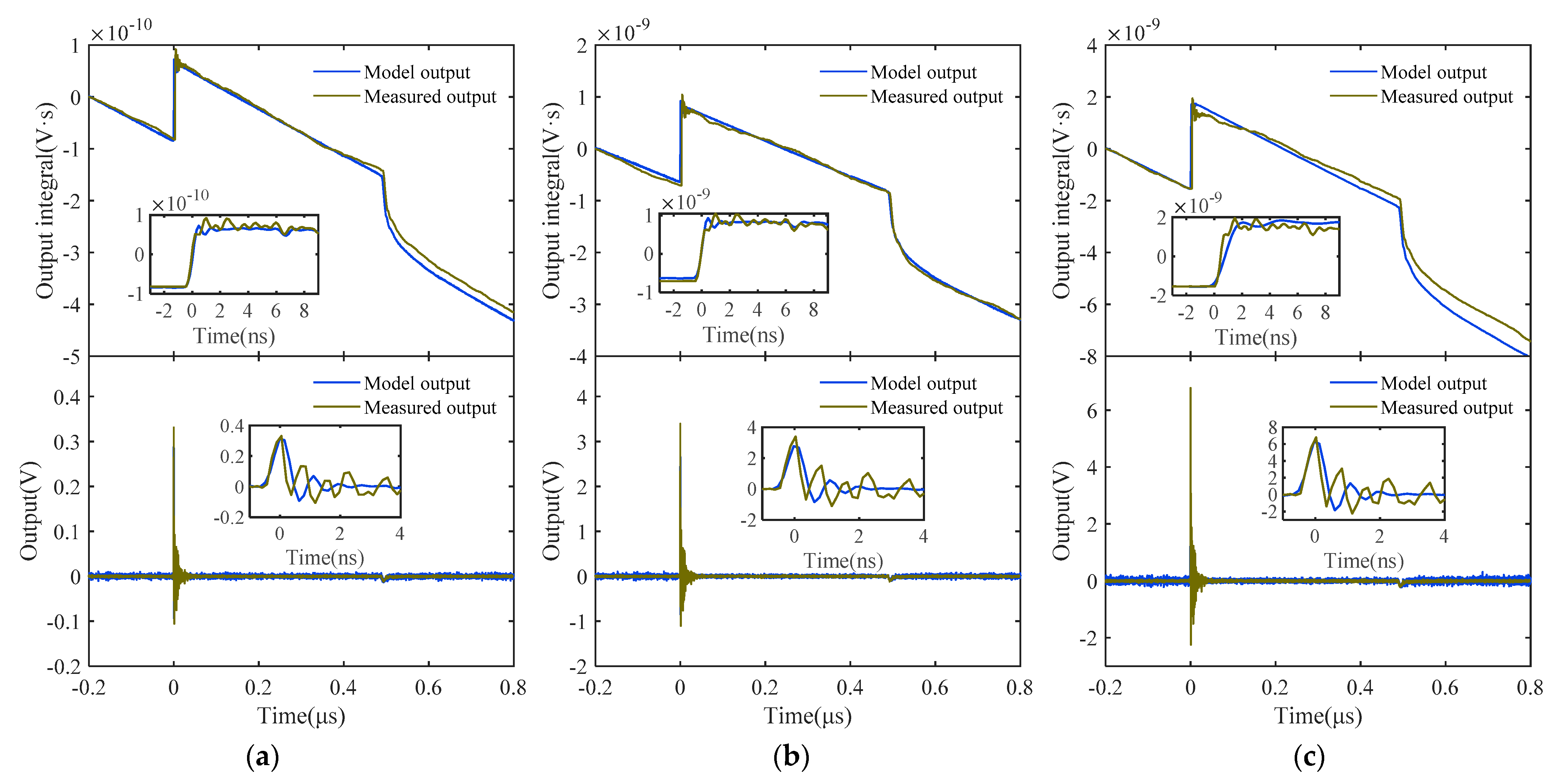
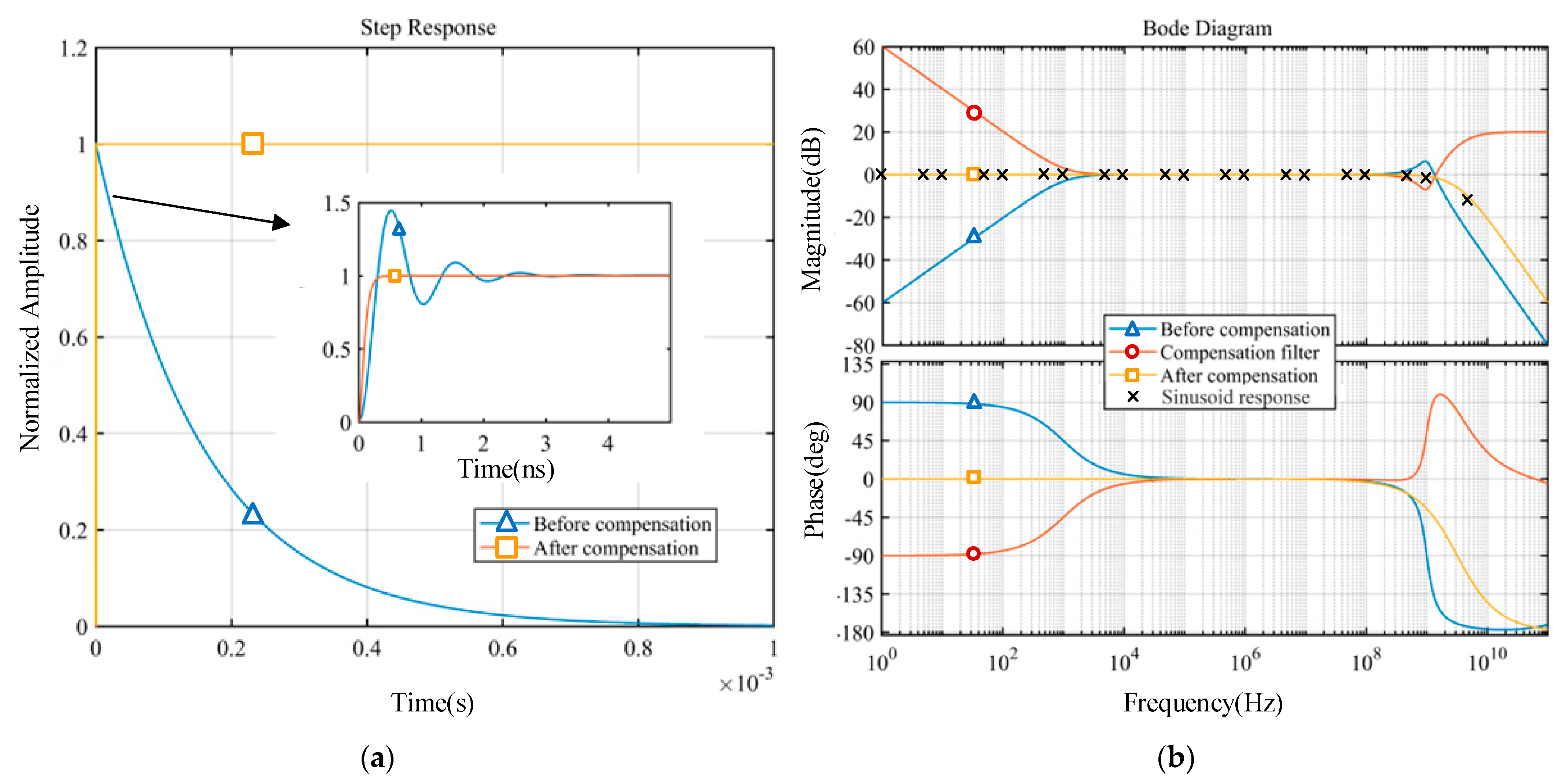
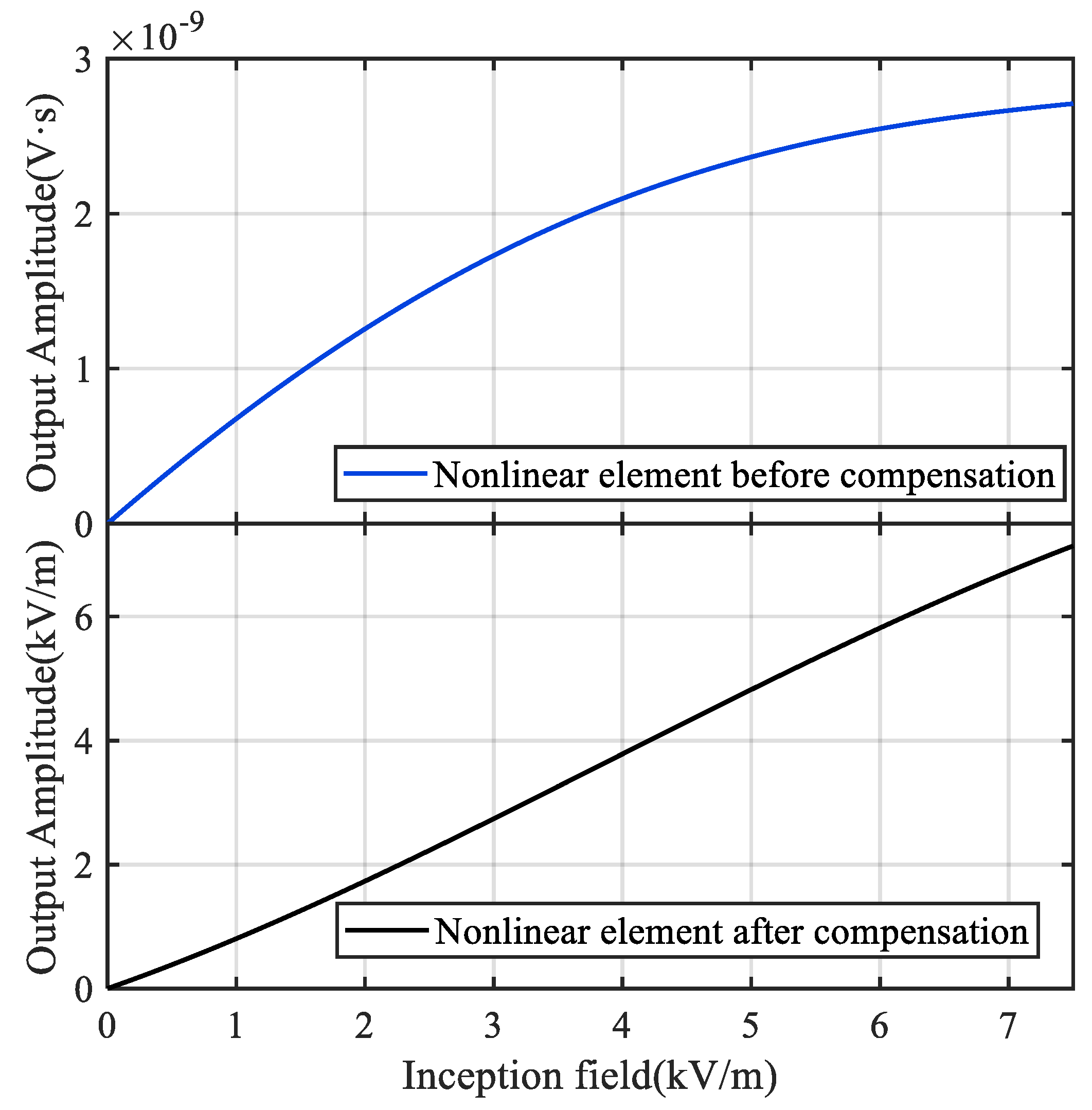

| Indicators | Time Domain | Frequency Domain | ||||
|---|---|---|---|---|---|---|
| tr/ns | tp/ns | tresp/ns | ωL/kHz | ωH/MHz | ωb/GHz | |
| Before compensation | 0.21 | 0.48 | 8.16 × 105 | 1.05 | 592.94 | 0.59 |
| After compensation | 0.17 | 0.30 | 0.28 | 0.00 | 2032.64 | 2.03 |
Publisher’s Note: MDPI stays neutral with regard to jurisdictional claims in published maps and institutional affiliations. |
© 2022 by the authors. Licensee MDPI, Basel, Switzerland. This article is an open access article distributed under the terms and conditions of the Creative Commons Attribution (CC BY) license (https://creativecommons.org/licenses/by/4.0/).
Share and Cite
Jin, M.; Li, H.; Liu, S. Identification and Compensation for D-Dot Measurement System in Transient Electromagnetic Pulse Measurement. Sensors 2022, 22, 8538. https://doi.org/10.3390/s22218538
Jin M, Li H, Liu S. Identification and Compensation for D-Dot Measurement System in Transient Electromagnetic Pulse Measurement. Sensors. 2022; 22(21):8538. https://doi.org/10.3390/s22218538
Chicago/Turabian StyleJin, Mengzhe, Hao Li, and Shanghe Liu. 2022. "Identification and Compensation for D-Dot Measurement System in Transient Electromagnetic Pulse Measurement" Sensors 22, no. 21: 8538. https://doi.org/10.3390/s22218538
APA StyleJin, M., Li, H., & Liu, S. (2022). Identification and Compensation for D-Dot Measurement System in Transient Electromagnetic Pulse Measurement. Sensors, 22(21), 8538. https://doi.org/10.3390/s22218538




